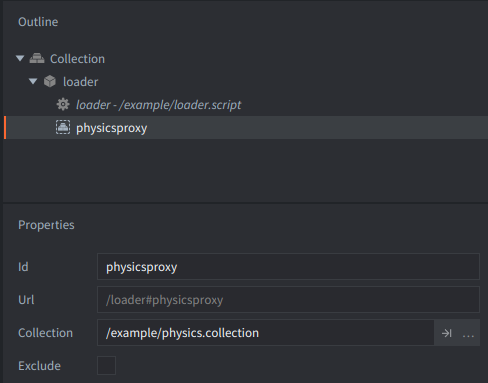Physics debug
Setup
With the physics visualization on, all collision object shapes are visible. In addition, at intersections the normals at the collision points are shown.
The example collection consists of:
- 4 blocks with dynamic collision objects with Restituion 1.0, so they bounce forever,
- 4 walls with static collision objects forming boundaries for the blocks,
- game object
gowith:- label with example description,
- a script
physics.scriptincluded below.

This collection is additionally loaded via a Collection Proxy component in main.collection. Therefore, sending message set_time_step to its url "main:/loader#physicsproxy" is causing the proxy to have a different update time, causing e.g. the slow-motion effect, which might be helpful when debugging physics.

Scripts
physics.script
function init(self)
msg.post(".", "acquire_input_focus") -- <1>
self.show_debug = false -- <2>
end
function on_input(self, action_id, action)
if action_id == hash("touch") and action.pressed then
msg.post("@system:", "toggle_physics_debug") -- <3>
if self.show_debug then -- <4>
msg.post("main:/loader#physicsproxy", "set_time_step", { factor = 1, mode = 0 })
else
msg.post("main:/loader#physicsproxy", "set_time_step", { factor = 0.1, mode = 1 })
end
self.show_debug = not self.show_debug -- <5>
end
end
--[[
1. Make sure this game object's script component gets input from the engine.
2. A state flag to track if we show debug info or not.
3. If user clicks, toggle physics visualization.
4. In addition, we want to set the timestep. That is done through the collection proxy that loaded this example. Since we cannot get hold of the proxy from this side of it we message the loader game object in the main collection and it will relay the message to the proxy component.
5. Switch the `show_debug` flag.
--]]loader.script
function init(self)
msg.post(".", "acquire_input_focus")
msg.post("#physicsproxy", "load")
end
function on_message(self, message_id, message, sender)
if message_id == hash("proxy_loaded") then
msg.post(sender, "init")
msg.post(sender, "enable")
end
end